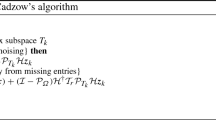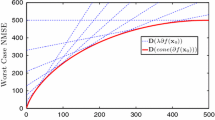Abstract
Paraunitary filter banks are important for several signal processing tasks, including coding, multichannel deconvolution and equalization, adaptive beamforming, and subspace processing. In this paper, we consider the task of adapting the impulse response of a multichannel paraunitary filter bank via gradient ascent or descent on a chosen cost function. Our methods are spatio-temporal generalizations of gradient techniques on the Grassmann and Stiefel manifolds, and we prove that they inherently maintain the paraunitariness of the multichannel adaptive system over time. We then discuss the necessary practical approximations, modifications, and simplifications of the methods for solving two relevant signal processing tasks: (i) spatio-temporal subspace analysis and (ii) multichannel blind deconvolution. Simulations indicate that our methods can provide simple, useful solutions to these important problems.
Similar content being viewed by others
References
P.P. Vaidyanathan, Multirate Systems and Filter Banks, Englewood Cliffs, NJ: Prentice-Hall, 1993.
D.T.M. Slock, “Blind Fractionally-Spaced Equalization, Perfect-Reconstruction Filter Banks, and Multichannel Linear Prediction,” in Proc. IEEE Int. Conf. Acoust., Speech, Signal Processing, Adelaide, Australia, vol. 4, 1994, pp. 585-588.
M.K. Tsatsanis and G.B. Giannakis, “Principal Component Filter Banks for Optimum Multiresolution Analysis,” IEEE Trans. Signal Processing, vol. 43, 1995, pp. 1766-1777.
A. Kiraç and P.P. Vaidyanathan, “Theory and Design of Optimum FIR Compaction Filters,” IEEE Trans. Signal Processing, vol. 46, 1998, pp. 903-919.
P. Moulin and M.K. Mthçak, “Theory and Design of Signal-Adapted FIR Paraunitary Filter Banks,” IEEE Trans. Signal Processing, vol. 46, 1998, pp. 920-929.
B. Xuan and R.H. Bamberger, “FIR Principal Component Filter Banks,” IEEE Trans. Signal Processing, vol. 46, 1998, pp. 930-940.
O.S. Jahromi, M.A. Masnadi-Shirazi, and M. Fu, “A Fast O(N) Algorithm for Adaptive Filter Bank Design,” in Proc. IEEE Int. Conf. Acoust., Speech, Signal Processing, Seattle, WA, vol. 3, 1998, pp. 1325-1328.
B. Porat and B. Friedlander, “Estimation of Spatial and Spectral Parameters of Multiple Sources,” IEEE Trans. Inform. Theory, vol. 29, 1983, pp. 412-425.
B. Ottersten and T. Kailath, “Direction-of-Arrival Estimation for Wideband Sources Using the ESPRIT Algorithm,” IEEE Trans. Acoust., Speech, Signal Processing, vol. 38, 1990, pp. 317-327.
P. Loubaton and P.A. Regalia, “Blind Deconvolution of Multivariate Signals by Using Adaptive FIR Lossless Filters,” in Proc. EUSIPCO92, Brussels, Belgiumx, 1992, pp. 317-327.
P.A. Regalia and P. Loubaton, “Rational Subspace Estimation Using Adaptive Lossless Filters,” IEEE Trans. Signal Processing, vol. 40, 1992, pp. 2392-2405.
P.A. Regalia and D.-Y. Huang, “Attainable Error Bounds in Multirate Adaptive Lossless FIR Filters,” in Proc. IEEE Int. Conf. Acoust., Speech, Signal Processing, vol. 2, Detroit, MI, 1995, pp. 1460-1463.
A. Benveniste, M. Goursat, and G. Ruget, “Robust Identification of a Nonminimum Phase System: Blind Adjustment of a Linear Equalizer in Data Communications,” IEEE Trans. Automat. Contr., vol. 25, 1980, pp. 385-399.
B. Farhang-Boroujeny and S. Nooshfar, “Adaptive Phase Equalization Using All-Pass Filters,” in Proc. IEEE Int. Conf. Commun., vol. 3, Denver, CO, 1991, pp. 1403-1407.
T. J. Lim and M.D. Macleod, “Adaptive Allpass Filtering for Nonminimum-Phase System Identification,” IEE Proc.—Vision, Image, Signal Processing, vol. 141, 1994, pp. 373-379.
S. Hakyin (Ed.), Blind Deconvolution. Englewood Cliffs, NJ: Prentice-Hall, 1994.
P.A. McEwen and J.G. Kenney, “Allpass Forward Equalizer for Decision Feedback Equalization,” IEEE Trans. Magnetics, vol. 31, 1995, pp. 3045-3047.
E. Abreu, S.K. Mitra, and R. Marchesani, “Nonminimum Phase Channel Equalization Using Noncausal Filters,” IEEE Trans. Signal Processing, vol. 45, 1997, pp. 1-13.
S.C. Douglas and S.-Y. Kung, “Gradient Adaptive Algorithms for Contrast-Based Blind Deconvolution,” J. VLSI Signal Processing Syst., vol. 26, nos. 1/2, 2000, pp. 47-60.
B. Widrow and E. Walach, Adaptive Inverse Control, Upper Saddle River, NJ: Prentice-Hall, 1996.
H.G. Grassmann, Die Ausdehnungslehre, Berlin: Enslin, 1862.
E. Stiefel, “Richtungsfelder und Fernparallelismus in n-Dimensionalem Manning Faltigkeiten,” Commentarii Math. Helvetici, vol. 8, 1935/1936, pp. 305-353.
E. Oja and J. Karhunen, “On Stochastic Approximation of the Eigenvectors and Eigenvalues of the Expectation of a Random Matrix,” J. Math Anal. Appl., vol. 106, no. 1, 1985, pp. 69-84.
L. Xu, “Least-Mean-Square Error Recognition Principle for Self-Organizing Neural Nets,” Neural Networks, vol. 6, 1993, pp. 627-648.
S.T. Smith, “Geometric Optimization Methods for Adaptive Filtering,” Ph.D. thesis, Harvard Univ., Cambridge, MA, 1993.
U. Helmke and J.B. Moore, Optimization and Dynamical Systems, New York: Springer-Verlag, 1994.
D.R. Fuhrmann, “A Geometric Approach To Subspace Tracking,” in Proc. 31st Asilomar Conf. Signals, Syst., Comput., vol. 1, Pacific Grove, CA, 1997, pp. 783-787.
T.-P. Chen, S. Amari, and Q. Lin, “A Unified Algorithm for Principal and Minor Components Extraction,” Neural Networks, vol. 11, 1998, pp. 385-390.
S.C. Douglas, S.-Y. Kung, and S. Amari, “A Self-Stabilized Minor Subspace Rule,” IEEE Signal Processing Lett., vol. 5, 1998, pp. 328-330.
A. Edelman, T. Arias, and S.T. Smith, “The Geometry of Algorithms with Orthogonality Constraints,” Siam J. Matrix Anal. Appl., vol. 20, 1998, pp. 303-353.
K.I. Diamantaras and S.-Y. Kung, Principal Component Neural Networks, New York: Wiley, 1996.
S.C. Douglas, S. Amari, and S.Y. Kung, “On Gradient Adaptation with Unit-Norm Constraints,” IEEE Trans. Signal Processing, vol. 48, no. 6, 2000, pp. 1843-1847.
P. Comon, “Independent Component Analysis: A New Concept?” Signal Processing, vol. 36, 1994, pp. 287-314.
N. Delfosse and P. Loubaton, “Adaptive Blind Separation of Independent Sources: A Deflation Approach,” Signal Processing, vol. 45, 1995, pp. 59-83.
S.-Y. Kung and C. Mejuto, “Extraction of Independent Components from Hybrid Mixture: KuicNet Learning Algorithm and Applications,” in Proc. IEEE Int. Conf. Acoust., Speech, Signal Processing, vol. 2, Seattle, WA, 1998, pp. 1209-1212.
S.C. Douglas, “Self-Stabilized Gradient Algorithms for Blind Source Separation with Orthogonality Constraints,” IEEE Trans. Neural Networks, vol. 11, no. 6, 2000, pp. 1490-1497.
S. Amari, “Natural Gradient Works Efficiently in Learning,” Neural Computation, vol. 10, 1998, pp. 251-276.
S.C. Douglas and S. Amari, “Natural Gradient Adaptation,” in Unsupervised Adaptive Filtering, vol. I: Blind Source Separation, S. Haykin (Ed.), New York: Wiley, 2000, pp. 13-61.
R.H. Lambert, “Multichannel Blind Deconvolution: FIR Matrix Algebra and Separation of Multipath Mixtures,” Ph.D. thesis, University of Southern California, Los Angeles, CA, May 1996.
S.C. Douglas and S. Haykin, “On the Relationship Between Blind Deconvolution and Blind Source Separation,” in Proc. 31st Ann. Asilomar Conf. Signals, Syst., Comput., vol. 2, Pacific Grove, CA, 1997, pp. 1591-1595.
I. Sabala, A. Cichocki, and S. Amari, “Relationships Between Instantaneous Blind Source Separation and Multichannel Blind Deconvolution,” in Proc. IEEE Int. Joint Conf. Neural Networks, vol. 1, Anchorage, AK, 1998, pp. 39-44.
S.C. Douglas and S. Haykin, “Relationships Between Blind Deconvolution and Blind Source Separation,” in Unsupervised Adaptive Filtering, vol. II: Blind Deconvolution, S. Haykin (Ed.), New York: Wiley, 2000, pp. 113-145.
S.C. Douglas, A. Cichocki, and S. Amari, “Fast-Convergence Filtered Regressor Algorithms for Blind Equalisation,” Electron. Lett., vol. 32, no. 23, 1996, pp. 2114-2115.
S.C. Douglas, A. Cichocki, and S. Amari, “Quasi-Newton Filtered-Error and Filtered-Regressor Algorithms for Adaptive Equalization and Deconvolution,” in Proc. 1st IEEE Workshop Signal Proc. Adv. Wireless Commun., Paris, France, 1997, pp. 109-112.
S.C. Douglas, A. Cichocki, and S. Amari, “Self-Whitening Algorithms for Adaptive Equalization and Deconvolution,” IEEE Trans. Signal Processing, vol. 47, 1999, pp. 1161-1165.
P. Comon, “Contrasts for Multichannel Blind Deconvolution,” IEEE Signal Processing Lett., vol. 3, 1996, pp. 209-211.
E. Moreau and J.-C. Pesquet, “Generalized Contrasts for Multi-channel Blind Deconvolution of Linear Systems,” IEEE Signal Processing Lett., vol. 4, 1997, pp. 182-183.
R.-W. Liu and Y. Inouye, “Direct Blind Signal Separation of Convolutive Mixtures of White Non-Gaussian Signals,” in Proc. 1st Int. Conf. Indep. Compon. Anal. Signal Sep., Aussois, France, 1999, pp. 233-238.
A. Gorokhov and J.-F. Cardoso, “Equivariant Blind Deconvolution of MIMO-FIR Channels,” in Proc. 1st IEEE Workshop Signal Processing Adv. Wireless Commun., Paris, France, 1997, pp. 89-92.
S. Amari, S.C. Douglas, A. Cichocki, and H.H. Yang, “Multichannel Blind Deconvolution Using the Natural Gradient,” in Proc. 1st IEEE Workshop Signal Proc. Adv. Wireless Commun., Paris, France, 1997, pp. 101-104.
K. Torkkola, “Blind Separation of Convolved Sources Based on Information Maximization,” IEEE Workshop Neural Networks Signal Processing, Kyoto, Japan, 1996, pp. 423-432.
R.H. Lambert and A.J. Bell, “Blind Separation of Multiple Speakers in a Multipath Environment,” in Proc. IEEE Int. Conf. Acoust., Speech, Signal Processing, vol. 1, Munich, Germany, 1997, pp. 423-426.
S. Amari, S.C. Douglas, A. Cichocki, and H.H. Yang, “Novel On-Line Adaptive Learning Algorithms for Blind Deconvolution Using the Natural Gradient Approach,” in Proc. 11th Ifac Symp. Syst. Ident., vol. 3, Kitakyushu, Japan, 1997, pp. 1057-1062.
S.C. Douglas and A. Cichocki, “Neural Networks for Blind Decorrelation of Signals,” IEEE Trans. Signal Processing, vol. 45, 1997, pp. 2829-2842.
Author information
Authors and Affiliations
Rights and permissions
About this article
Cite this article
Douglas, S.C., Amari, SI. & Kung, SY. Gradient Adaptive Paraunitary Filter Banks for Spatio-Temporal Subspace Analysis and Multichannel Blind Deconvolution. The Journal of VLSI Signal Processing-Systems for Signal, Image, and Video Technology 37, 247–261 (2004). https://doi.org/10.1023/B:VLSI.0000027489.11890.2a
Published:
Issue Date:
DOI: https://doi.org/10.1023/B:VLSI.0000027489.11890.2a




